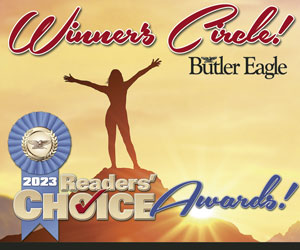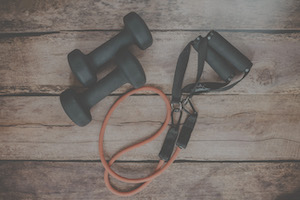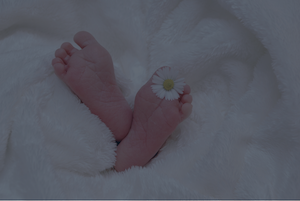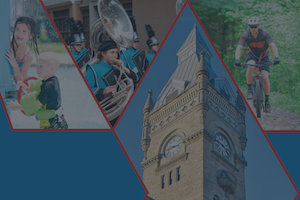Library has called the same spot home since the 1920s
It began in 1894 in one room on a block shared with stables and a fishmonger’s shop.
In its 131-year history, the Butler Area Public Library has undergone moves, renovations, a pandemic, a ransomware attack, recurrent financial woes and curated an ever-increasing collection of books, magazines, e-books, vinyl records, audiobooks, CDs, microfilms and genealogical materials.
By 1987, the Butler’s library joined with eight other county libraries to form the Butler County Federated Library System which created an online catalog database and allows the system’s 414,817 patrons to use one library card at any library in the county.
It’s a long way from the single room, a group of Butler women’s literary society opened on Feb. 16, 1894. According to the library’s own history, this first library began modestly, with just 432 books in a rented room in the Duffy Building on West Jefferson Street.
The group paid for rent and books through a “Woman’s Industrial Exchange” shop on-site, where women sold handmade items and baked goods on consignment.
By 1899, the library moved to a room on the second floor of the Bickel Building at 128 S. Main St., but the need for more space prompted the library to again move to the home of a Miss Mary Miller on North Main Street in 1904. At this location, the library offered its patrons a public reading room.
In 1908, the library moved into the Little Red Schoolhouse on East Jefferson Street, which would be its home for the next 13 years.
According to the Butler Citizen newspaper, the library opened its first branch in Red Row Settlement House on Jan. 6, 1914. The Citizen reported “It will have a reading room for foreign speakers. R.M. Corbett organized a class in English. It will have 50 Slovak, Bohemian and Hungarian books on loan from the Carnegie Library in Homestead. It needs Russian and Syrian books.”
The Butler Eagle reported on Aug. 16, 1916, that a campaign to raise money for a new library had begun because the library had outgrown its schoolhouse location.
By May 22, 1920, the Eagle reported the Butler City Council had agreed to formally accept a North McKean Street site as the library’s new location. The property, the former W.D. Brandon homestead, was purchased from its present owner T.W. Phillips Jr. The 218 N. McKean St. site, with many alterations and additions, is the library’s present location.
The Eagle reported, “With the erection of a handsome municipal building on the city lot just adjoining that chosen for the library site, within a few years it will be a solid square of public buildings which will greatly add to the beauty and value of that part of Main Street.”
The building was to be paid for with $25,000 raised by the Library Association and $37,000 from the Carnegie Foundation.
Created by Andrew Carnegie, the Scottish immigrant to Pittsburgh, who founded Carnegie Steel and by 1919 was believed to be one of the richest Americans in history, the Carnegie Foundation is chiefly remembered for helping to create public libraries.
The first library opened in Carnegie’s hometown Dumferline, Scotland, in 1883. Of the first 13 libraries Carnegie helped build in the United States, nine were in Pittsburgh. By 1898, Carnegie began expanding his efforts across the United State encouraged by women’s groups organizing to establish community libraries.
Nearly all of Carnegie's libraries were built according to “the Carnegie formula,” which required financial commitments for maintenance and operation from the town that received the donation.
Carnegie required public support rather than making endowments because, as he wrote: “An endowed institution is liable to become the prey of a clique. The public ceases to take interest in it, or, rather, never acquires interest in it. The rule has been violated which requires the recipients to help themselves. Everything has been done for the community instead of it’s being only helped to help itself.”
As a Carnegie library, Butler’s city government was required to provide the building site, pay the staff and maintain the library, draw from public funds to run the library and not use only private donations, each year provide 10 percent of the cost of the library’s construction to support its operation and provide free service to all.
The original library was described as tapestry brick structure of modified colonial design with frontage of 70 feet on McKean Street. The one-and-a-half story building had a slate roof and central skylight. The main entrance opened onto a vestibule with steps leading up to the rotunda centered on the librarians’ desk. There was a reading room on the right, a children’s room to the left and a reference room and offices in the rear.
Book stacks rose from the basement up through the first floor with access to the stacks at the rear of the central desk. A third of the basement was designed as an auditorium or lecture room with an additional club room.
The new library was dedicated on Sept. 20, 1921, and reported it has issued cards to 1,137 patrons under the age of 14 and 2,668 adults.
On June 4, 1922, Susan Sherman was appointed librarian and the library added a foreign department. The Butler Eagle reported on the new feature, “And it is certainly a wide and right field for the Americanization organizations that are working on the problem of the assimilation of the immigrant.”
A victim of its own success, the Butler Eagle reported on Oct. 28, 1922, “50 kiddies were in attendance” every afternoon, there was never more than 200 books on the shelves, the auditorium and committee rooms were in use by groups such as the National Purity League and “money to buy more books was nearly exhausted.”
On Nov. 20, 1922, the Kiwanis announced a drive to donate or purchase more books for the library. The Butler Eagle reported, “The Butler Public Library has been unable to supply the demand for juvenile fiction. Juvenile, historical and scientific volumes are also accepted.”
On Oct. 25, 1927, Susan Sherman, the librarian who had been in ill health “was stricken while attending a state librarians’ meeting in Harrisburg” and died. The library was closed until after her funeral.
Through the years, library’s books kept increasing. In 1937, it reported 19,068 volumes on its shelves. By 1953, its collection had risen to 25,000 books.
But apparently library maintenance had not kept pace with the growth of its book collection. A Butler Eagle columnist wrote on Nov. 8, 1954, the library was badly lit and dingy with worn floors and faded paint. He started Operation New Look and appealed to the Butler community to contribute supplies and labor to spruce it up.
On Dec. 13, 1954, the newspaper reported Carpenters Union Local 500 members had volunteered to install a new floor and paid for the materials while Brotherhood of Electrical Workers Local 10 installed new lights. J.C. Ashman Painting Contractor employees painted walls with paint supplied by the local Sherwin Williams store. Butler City Council donated $1,000 toward the effort.
In 1966, the library began work on a $250,000 expansion project, adding a new wing at the rear of the present building and adding air conditioning to both.
By Nov. 16, 1974, the library reported it had 52,660 books and 25,647 borrowers.
The library’s annual operating budget for 1985 was listed as $200,000 with 71% coming from endowments and gifts, 20% from the city and the rest from the state.
On April 4, 1985, the library announced a $500,000 capital fund drive designed to finance improvements to the existing building and the recently purchased former Luther Hall.
The project called for additional study space, the addition of a job and career center, more public meeting space, handicapped access, roof repair, winterization, replacing 17-year-old carpeting, a space for a computerized circulation system, the creation of a separate genealogy room and a separate microfilm room. The former Luther Hall. and the existing library building were joined with the new portion functioning as the children’s library.
According to the Butler Area Public Library’s history, the library joined with eight other libraries in the Butler County Federated Library System which was founded by the Butler County Commissioners in 1987. Its purpose was to operate a system of autonomous public libraries within Butler County to promote, develop and improve library and informational services for all county residents. The system provides the hardware, software and technical support for the countywide library system.
Krista Conway, the system manager of the Butler County Federated Library System, said Butler, Cranberry, Evans City, Mars, North Trails, Prospect, Slippery Rock, South Butler and Zelienople libraries are part of the system.
Conway said, “The system employs four staff. Myself, as the system manager, and three employees who staff the North Trails Public Library (the branch library of the system). They are the branch director, a children's librarian, and a circulation desk.”
The North Trails site was originally a book depot for a bookmobile program that was discontinued.
“The BCFLS budget is split into 3 budgets: administrative, North Trails Public Library and technology, totaling about $1 million,” said Conway. “It is funded by the state, commissioners’ donation, and any other grants and donations we might receive. Most of the administrative budget gets divvied out to the libraries in the system that are state funded.”
The BCFLS is governed by a seven-member board of directors appointed by the Butler County Commissioners.
In 1993, cuts in state and local funding create a $35,000 shortfall in funding for the Butler Area Library. Library officials threaten to close the library for a month in August to balance its budget.
On March 12, 1993, Ron Vodenichar, the general manager of the Butler Eagle, and Dale Pinkerton of Pinkerton Goodyear, announced a campaign to make up the missing money. On April 25, they announced the campaign has raised $42,000, forestalling the August closing.
In 2003, the library completed its first major renovation project since 1966, installing new wall coverings, carpet, floors, ceilings, a new climate-controlled genealogy department, adding computers and converting the old basement meeting rooms into a 150-seat space with a divider and a kitchenette.
A 2009 Duquesne University study listed the Butler Library as 12th in size among Pittsburgh area libraries and ninth in number of cardholders with 27,360.
On Dec. 9, 2011, the library opened the William Lehnerd Music Center, a space created by a LaRoche College student interior design team and funded by the William Lehnerd Foundation
In 2013, the library used a second LaRoche College student interior design team in the construction of the Bertram and Esther Shaffer Teen Zone incorporating a book collection, study area and gaming/socializing section.
In January 2018, the library system announces all libraries will be offering its patrons the Overdrive digital system which allowed the option of downloading books and audio books to the patrons’ tablets, laptops, smartphones and Nook/Kindle devices. Digital books would stay on the devices for two weeks then disappear.
At the time, Tiffany Harkleroad, the youth services librarian at the Butler Library, told the Butler Eagle, “It’s increased interest in paper books and brought literacy to people who might not think of themselves as readers.”
But the digital age also has had its drawbacks.
In July 2019, the entire library system was subjected to a ransomware attack that caused problems with the public computers at all libraries as well as affecting printers and the libraries’ WiFi.
Lori Hinderliter, the executive director of the Butler Area Public Library, said of the ransomware attack, “It would take a couple of months to get things up and running, but it took about a year to get back to where we were. We still lost files.”
All library services, as well as the libraries themselves, faced disruptions brought on by the evolving COVID-19 pandemic. It culminated on April 1, 2020, when Pennsylvania Gov. Tom Wolf ordered that all libraries in the state close indefinitely.
Hinderliter said the county’s libraries earlier decided to shut down on March 13, 2020, in the face of the pandemic.
“Until the end of May we did nothing. In June we started doing book drops, grab and goes out in the lobby,” she said. “We had summer programs out in the yard. We started again but we were forced to close, back off again, because of the levels of COVID were higher.”
Innovations to increase patrons’ access to the libraries’ offerings continue in 2025.
Hinderliter said, “I would say we have been able to expand online to provide more access to the libraries. Many of the libraries have undergone smaller renovations.”
Conway said, “We also just launched the TLC Go! mobile app, which allows patrons to search through our catalog, place holds, browse e-books and audio books, and more directly through their phone.”
In addition, Conway said, “We have our passport tour coming up in conjunction with our libraries' Summer Reading programs. We launched this last year, where patrons were given passports to visit each library and receive a stamp. If they visited five of the nine libraries, they were entered into a drawing for a prize. This year, we are doing this again but adding to it. For additional entry opportunities, patrons will have to find a mini bigfoot figurine and take a selfie with it. Each bigfoot selfie at a different library enters them into the drawing as a bonus entry.”













